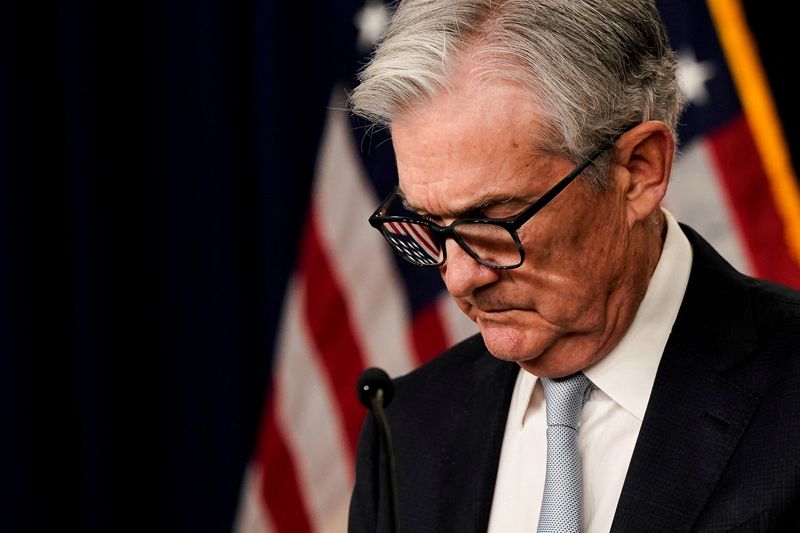Investing.com’s stocks of the week
By Ann Saphir and Michael S. Derby
(Reuters) - Federal Reserve Chair Jerome Powell on Tuesday foreshadowed key elements of the central bank's upcoming rate-setting meeting: A half-point increase is on the table and updated policymaker forecasts are likely to feature a high point for rates above the 5.1% in their last projections in December.
Economic data released since the Fed's last meeting, held Jan. 31-Feb. 1, has surprised consistently to the upside, suggesting the 4.5 percentage points of rate hikes since March 2022 have yet to sufficiently slow the economy to beat back inflation.
"Nothing about the data suggests to me that we've tightened too much - indeed, it suggests that we still have work to do," Powell said. "It's hard to make a case that we've over-tightened. It means we need to continue to tighten."
Just how high and how fast Powell and his colleagues are willing to go will hinge on a clutch of key reports between now and the rate-setting Federal Open Market Committee's March 21-22 meeting, starting with employment data due this week.
"We have two or three more very important data releases to analyze before the time of the FOMC meeting," Powell told the Senate Banking panel Tuesday. He is set to testify to the House of Representatives Financial Services Committee on Wednesday.
"Those are going to be very important in the assessment we have of this relatively recent data," he said, noting that if the "totality" of data warrants, the Fed would be prepared to speed up its rate-hike pace.
The remarks together lay the groundwork for the Fed to keep raising rates until they touch 6%, and induce a recession along the way, SGH Macro Advisors' Tim Duy said.
"Powell didn’t open the door to a 50-basis-point rate hike without intending to follow through with that outcome at the March FOMC meeting," Duy said. "Only surprisingly weak data will prevent that outcome now."
The Fed's policy rate is now in a range between 4.50% and 4.75%.
Here's what to watch for between now and March 21 when policymakers deliver their rate decision in Washington:
JOBS REPORT, DUE FRIDAY
Graphic: Payroll growth remains strong Payroll growth remains strong https://www.reuters.com/graphics/USA-FED/JOBS/byvrjgewnve/chart.png
The U.S. Labor Department's last monthly report, published just days after the Fed delivered its smallest rate hike in a year, showed a gain of more than half a million jobs in January, though a slowdown in hourly wage growth tempered concern over the impact on inflation.
Economists estimate 203,000 jobs were added in February, a significant cooling, but they also expect a return in average hourly earnings growth to the 4.8% seen in December. That's far above the 3.5% wage growth that Fed policymakers often point to as being consistent with their 2% inflation goal.
Powell said Tuesday the labor market has to soften if inflation is to recede. He also said he does not expect the rise in the unemployment rate over the course of this round of rate hikes to be much more than the one percentage point the Fed estimated in December.
Economists expect the report to show the unemployment rate, which was 3.4% in January, rose to 3.5% in February.
INFLATION, DUE MARCH 14
Graphic: As goods inflation eases, services step in As goods inflation eases, services step in https://www.reuters.com/graphics/USA-FED/INFLATION/lbvgndazapq/chart.png
The Bureau of Labor Statistics' consumer price index, the most widely followed gauge of U.S. inflation, is expected to show a slight slowdown in price pressures, easing to a month-over-month gain of 0.4% in February from 0.5% in January.
Either way, that's far above the Fed's goal, which requires an average monthly CPI gain of under 0.2%, analysts estimate.
Analysts will be particularly focused on the strength of services not tied to housing, which accounts for a little more than half of the inflation index. That has remained hot even as goods inflation has eased.
RETAIL SALES, DUE MARCH 15
Graphic: Consumers resumed spending in January in a big way https://www.reuters.com/graphics/USA-ECONOMY/RETAIL/gkvlwlzlopb/chart_eikon.jpg
Estimates are still preliminary, but economists expect retail sales, which exploded expectations by rising 3% in January, eased to a 0.2% gain in February. It's not clear what level of retail sales would be seen as sufficiently cool for the Fed. Consumer spending makes up two-thirds of the U.S. economy. The Fed's rate hikes are designed to slow demand and spending by consumers and businesses.
INFLATION EXPECTATIONS, DUE MARCH 17
An unexpectedly high reading from the University of Michigan on longer-term consumer inflation expectations last June helped spur the first of four straight 75-basis-point rate hikes, propelling what had begun as a more staid round of tightening into the most aggressive rate-hike campaign since the 1980s.
The survey will next publish on the Friday before the Fed meeting, and could again prove key. The latest read showed one-year inflation expectations increased to 4.2%, from 3.9% in January, while the five-year inflation outlook remained at the bottom of the narrow 2.9-3.1% band that has prevailed for 18 of the last 19 months. Powell and his colleagues are watching those closely, along with market-based indications of expectations.
If inflation continues, Powell said Tuesday, at some point both individuals and businesses "will come to expect high inflation, and that will make it more self-perpetuating."
